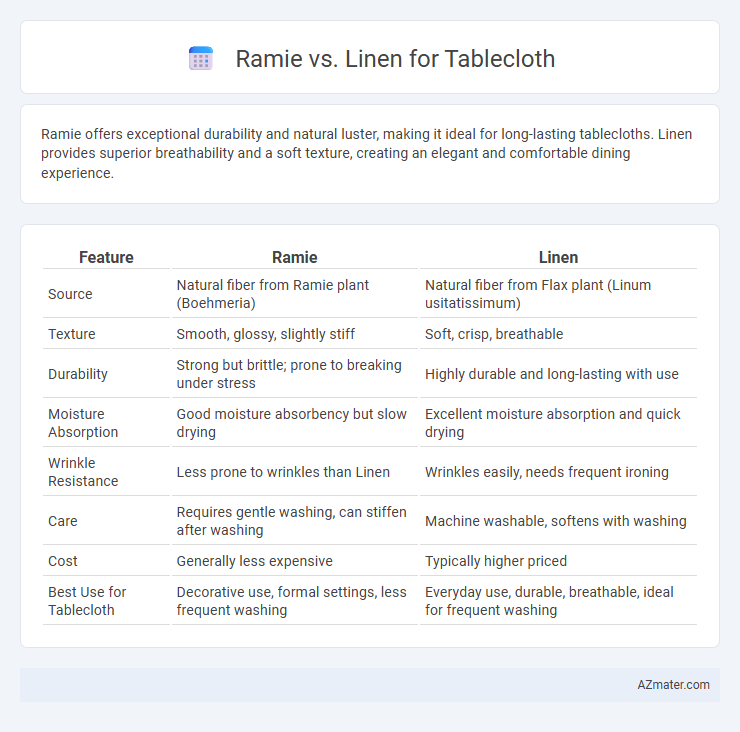Ramie offers exceptional durability and natural luster, making it ideal for long-lasting tablecloths. Linen provides superior breathability and a soft texture, creating an elegant and comfortable dining experience.
Table of Comparison
| Feature | Ramie | Linen |
|---|---|---|
| Source | Natural fiber from Ramie plant (Boehmeria) | Natural fiber from Flax plant (Linum usitatissimum) |
| Texture | Smooth, glossy, slightly stiff | Soft, crisp, breathable |
| Durability | Strong but brittle; prone to breaking under stress | Highly durable and long-lasting with use |
| Moisture Absorption | Good moisture absorbency but slow drying | Excellent moisture absorption and quick drying |
| Wrinkle Resistance | Less prone to wrinkles than Linen | Wrinkles easily, needs frequent ironing |
| Care | Requires gentle washing, can stiffen after washing | Machine washable, softens with washing |
| Cost | Generally less expensive | Typically higher priced |
| Best Use for Tablecloth | Decorative use, formal settings, less frequent washing | Everyday use, durable, breathable, ideal for frequent washing |
Introduction to Ramie and Linen Tablecloths
Ramie and linen tablecloths are natural fiber options prized for their durability and texture, with ramie derived from the stalks of the Chinese nettle plant and linen made from flax fibers. Ramie offers a lustrous, silky appearance and excellent resistance to bacteria and mold, while linen is known for its breathability and classic crisp feel. Both materials provide eco-friendly, sustainable choices for table settings that enhance elegance and functionality.
Origin and Production of Ramie vs Linen
Ramie is derived from the stalks of the Boehmeria plant, predominantly cultivated in China and parts of Southeast Asia, where it undergoes retting and decortication to extract its fibers. Linen originates from the flax plant, primarily grown in Europe, especially Belgium and France, and requires retting, drying, and scutching processes to separate fibers. Both ramie and linen fibers are valued for their strength and durability, but ramie's production is generally more labor-intensive due to its tough plant resin content.
Fiber Characteristics: Ramie Compared to Linen
Ramie fibers are naturally lustrous, stronger, and more absorbent than linen, making them highly durable and moisture-wicking for tablecloth use. Unlike linen, ramie resists bacterial growth and mold, ensuring enhanced hygiene and longevity in humid environments. Both fibers provide a crisp texture, but ramie's fine, silky surface offers a smoother, more luxurious feel compared to the coarser, rustic texture of linen.
Durability and Longevity: Which Lasts Longer?
Ramie fibers are known for their exceptional strength, often stronger than linen, making ramie tablecloths highly durable and resistant to wear over time. Linen, derived from flax fibers, also offers excellent longevity but tends to soften with use, which may reduce its stiffness but not its lifespan. When comparing durability, ramie tablecloths generally last longer due to their higher tensile strength and resistance to mildew and stretching.
Appearance and Texture: Visual and Tactile Differences
Ramie tablecloths boast a lustrous sheen and smooth finish, offering a slightly stiffer texture that enhances formal dining settings. Linen fabrics present a matte appearance with natural slubs, providing a softer, more breathable feel and a relaxed, rustic aesthetic. The tactile contrast lies in ramie's rigidity versus linen's pliability, influencing the overall table ambiance through their distinct visual and textural qualities.
Maintenance and Care Requirements
Ramie tablecloths require gentle washing with mild detergents to preserve their natural luster and prevent fiber weakening, avoiding bleach and high heat. Linen tablecloths are more durable but benefit from hand washing or delicate machine cycles, with ironing recommended on damp fabric to maintain smoothness. Both fabrics should be air-dried away from direct sunlight to reduce fading and fabric damage.
Stain Resistance and Washability
Ramie tablecloths exhibit excellent stain resistance due to their naturally smooth fibers, making them less absorbent and easier to clean compared to linen. Linen, while highly durable and breathable, tends to absorb stains more readily because of its porous texture, requiring careful washing to maintain appearance. Both fabrics can be machine-washed, but ramie generally withstands frequent laundering better, retaining its shape and color with less fading.
Environmental Impact and Sustainability
Ramie and linen both offer sustainable options for tablecloths, as ramie is derived from the stalks of the Ramie plant and linen from the flax plant, both requiring less water and pesticides compared to cotton. Ramie fibers are highly biodegradable and fast-growing, promoting soil health without heavy chemical inputs, while linen fibers are also biodegradable, with flax cultivation supporting crop rotation and reducing soil erosion. Choosing ramie or linen tablecloths minimizes environmental impact by leveraging natural, renewable fibers with lower carbon footprints and enhanced durability.
Price Comparison: Ramie vs Linen Tablecloths
Ramie tablecloths generally offer a more affordable price point compared to linen, making them a budget-friendly alternative for durable, natural fabric options. Linen tablecloths tend to command higher prices due to their premium quality, breathability, and long-lasting fiber strength. Consumers seeking cost-effective yet elegant table coverings often choose ramie for its similar aesthetic and texture at a lower cost.
Choosing the Best Option for Your Table
Ramie tablecloths offer exceptional durability and a natural luster, making them ideal for frequent use and elegant settings, while linen provides a softer texture and excellent breathability, enhancing comfort and a classic aesthetic. Consider ramie for high-traffic areas requiring easy maintenance and longevity, whereas linen suits formal occasions where a refined, timeless look is preferred. Selecting between ramie and linen depends on balancing the need for strength and ease of care versus tactile softness and traditional charm for your table.

Infographic: Ramie vs Linen for Tablecloth
 azmater.com
azmater.com